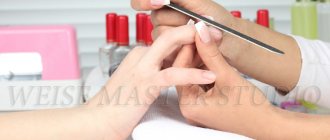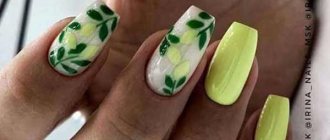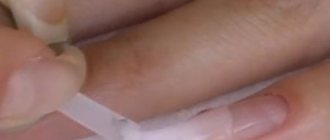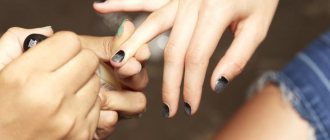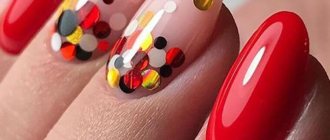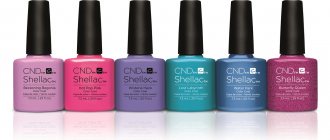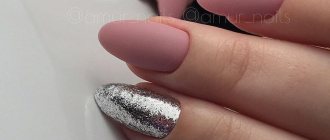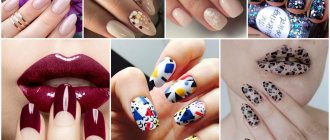Interesting Facts
"Manus" - hand, "cura" - care. This is exactly how the familiar word “manicure” is translated from Latin. A set of cosmetological actions aimed at improving the condition of the nail plate and hands, as well as improving their aesthetic appearance.
Some interesting facts:
- The first manicure appeared more than 5,000 years ago. Then natural henna or charcoal helped to add color, and natural gold tools were used to process the nail bed and cuticle.
- A little later, 2,000 years later, slaves received permission to have manicures. They were allowed to paint short nails and use only subtle colors;
- During the Inquisition, painted nails were considered a sign of witchcraft. Fashionistas were burned at the stake;
- Only in 1914 was the first officially registered patent for a nail protection product, in other words, varnish.
Initially, manicure was used to maintain healthy nails and hygiene, and after just a couple of hundred years it also became an indicator for determining class.
You can't watch it without laughing
Cool statuses about red nails and not only about red nails can be posted by those who are simply annoyed by bad taste:
- Nails are the second to last thing men notice, so don't spend your last money on a manicure. Better get your head in order.
- I’ll get a manicure and let everyone think I’m respectable and successful.
- A manicure is an indicator that everything in a person is already beautiful! And the red manicure means that he still needs to work on himself.
- “You can be a practical person and think about the beauty of your nails” - as the classic is right. But beauty is not in colorfulness, but in style.
- When I see photos of only nails, the question arises: “Is everything else so scary?”
- I skip the advertisement right away - the nails of unknown people are even scary, especially red ones.
- What's the page with nails? This is some kind of trash.
- I'm afraid of pages with only nails, I just want to add claws.
- Red nails are an emblem of sadness, because their owners certainly do not understand anything about the psychology of men.
- Doing red nails means thinking that men, like bulls, will immediately rush to the red color.
- My man is completely unpretentious to my appearance. Even when I change my hairstyle, he doesn’t notice anything, and what can we say about my nails... Even red nails go unnoticed.
- I like everything about her - except for her big and red nails - like a vampire...
- Don’t show off your red nails in photos - it’s clear that they were made with the last of the money.
- Oh, what a beauty – I just want to say it when I see a rare photo of a girl without red nail extensions.
- Nothing makes a person look better than unpainted nails.
- Don't put rhinestones on red nails - it makes you feel like you have problems with taste.
- Drawings on red nails are a sign that you have nothing to do with your life.
How manicurists and pedicurists appeared
Masters appeared almost immediately after the emergence of the tradition of nail care. Excavations in Ancient Egypt have proven that special people cared for the hands of representatives of the upper classes even before our era.
In one of the tombs, in addition to court servants and other associates, the remains of the pharaoh’s nail guardians were found. It was these people who took care of nails and painted them.
Masters appeared in Russia only at the beginning of the last century. It was then that car polish appeared and began to be used to decorate nails. Initially, there were not many manicurists, but with the development of progress and an increase in the range of care options, interest in this profession also grew.
Do as I do
Statuses about beautiful nails are often posted by their owners - with pride and an appeal to others to do the same:
- Beautiful nails are sometimes more attractive than plump lips.
- The beauty of nails inspires confidence in a woman, which means that everything is ok with taste.
- Beautiful nails are not necessarily bright, with a pattern or rhinestones, they are just elongated holes that speak of the aristocratic origin of their owner.
- You may not be beautiful, but you simply must have beautiful nails.
- Beauty is a relative concept: for some, the beauty of the soul is important, and for others, beautiful nails.
- Beautiful nails will look good, but smart heads will come in handy.
- The more beautiful the nails, the more undoubtedly the reputation.
- I'm not a snob, but the brightness of my nails just pisses me off - better look in the mirror!
- With beautiful nails, people will come to you.
- The beauty of nails is a sign of a woman’s taste.
- Only a stylist can evaluate whether nails are beautiful or not, but often stylists are of the wrong orientation. And why should we care about their ratings?
- You shouldn’t hide your nails, but quietly be proud of them.
- When you catch glances at your nails, you understand that you didn’t spend 3 thousand rubles in vain.
- Beautiful nails should emphasize a beautiful appearance, but this is not always an indicator of a beautiful soul.
- The beauty of your nails depends entirely on your taste; the more beautiful they are, the better you feel inside.
Ancient Babylon
Doing manicures was the prerogative of men, and even then the first color palette appeared. Representatives of the upper classes painted the nail plate black - a sign of humility, and the lower ones - green. It was the Babylonian manicurists who invented the most expensive set of tools made of pure gold, found during excavations of burials. The Babylonians also became the founders of nail art - the richest representatives of the people could decorate their nails with pieces of gold.
The most ancient origins of manicure art
For those who are interested in the history of manicure, it will be very interesting that in Ancient Egypt it was possible to determine by the nails which class a person belonged to. Noble people painted their nail plates in bright and rich colors, but slaves were allowed to use only pale pastel shades. During the Middle Ages, henna was a very popular dye, which Cleopatra herself loved to use. Her long nails were always painted a rich terracotta color.
In Ancient China, special attention was paid to nails. It was believed that a long manicure was a sign of wisdom, so the Chinese carefully grew their nail plates and painted them in different colors. The history of manicure of this period is marked by the fact that the Chinese learned to make varnish from natural ingredients and natural dyes. To do this, they used gelatin, egg yolks, gum arabic and wax, creating vibrant shades by adding natural dyes. Later, varnishes based on silver and gold became popular, and during the reign of the Ming Dynasty, red and black colors were considered more relevant and in demand. In the East in the 17th century, women exhausted themselves with the most complex procedures, during which a dye of plant origin was introduced into the matrix of the nail plate. This allowed them to grow colored nails.
The history of manicure in Ancient Greece is associated with ancient rituals and superstitions. Manicurists of those times never completely painted over the nail plate, leaving a hole of natural color. The ancient Greeks identified this part of the nail with the moon, believing that there was something mystical in this tradition. Some Old Believers still believe that sorcerers and magicians can communicate with spirits through their nails.
For a long time, long and bright nails were considered unacceptable and indicated bad taste. Short natural nails, painted in discreet tones, have become fashionable. Bright shades of manicure were preferred by courtesans, actresses and fallen women. And in the 16th century, owners of colored nails were called witches and could be burned at the stake.
Ancient Egypt
Nefertiti and later Cleopatra were famous for their beauty and paid great attention to detail. Hand care involved not only covering with color, but also moisturizing the skin of the hands with oils. When choosing a color, Cleopatra preferred rich red, and Nefertiti preferred a ruby shade. By the way, despite her well-known eccentricity and willfulness, Queen Cleopatra gave Julius Caesar a manicure with her own hands.
Manicure and nail art these days
A modern woman does not need to invent anything when lengthening her nails, since now it is possible to create a neat and beautiful manicure using gel or acrylic. As for hand care, we can safely say that today we have a huge number of tools and cosmetics to maintain the beauty of a manicure. There are also no problems with the choice of varnishes, since the market offers a wide selection of decorative coatings from various brands. Today we have convenient modern technologies; several types of manicure are available to us, differing in the sequence of processes and the use of various tools.
Summarizing the above, I would like to note that manicure is an art that has its own interesting history, rooted in the distant past. At different times, manicure was treated differently, but one thing remained unchanged: beautiful and well-groomed hands are always held in high esteem . Take care of your manicure and always look perfect!
Ancient China
Chinese women loved not only to paint their nail plates, but also to surprise with their incredible length. They deliberately did not cut off the overgrown nail in order to show others their importance and demonstrate luxury. To prevent overgrown nails from breaking, the Chinese came up with special protective covers - one for each nail. The tips were made of gold and silver, which made them accessible only to the rich.
Dyeing was a long procedure, especially if a woman wanted a bright crimson color. Natural dye, made from natural components, was applied to the plate from 3 to 14 times. With each new layer the color became more saturated.
By the way, natural plant leaves were used for the procedure, which were filled with dye, wrapped around a finger and secured with thread.
19th century France
In 1830, trouble happened - the then reigning King Louis acquired a problem in the form of a hangnail. The painful rupture of the skin caused the man a lot of trouble, so Louis ordered to find a doctor who would help get rid of the hangnail. The king’s hands saw dozens of doctors, and only Dr. Zitts was able to cope with the problem. For the procedure, he used a nail file and natural suede and an orange stick. Later, such sets were in the arsenal of every French woman.
Introduction to the specialty. History of manicure. Basics of modern manicure.
Introduction to the specialty. As the great classic rightly noted: “You can be a smart person and think about the beauty of your nails.” What do our hands and nails say? About many things. Neither careful makeup, nor an elegant hairstyle, nor an expensive dress can compensate for unkempt nails with chipped varnish. By shaking hands when meeting, we give ourselves a complete description; hands are our business card. Healthy, beautiful nails demonstrate our excellent health, which earns the respect of others. Therefore, a manicure and pedicure master was, is and will be one of the most popular, profitable and creative professions. The choice of profession in our time is of great importance. Our specialty is not just an effective means of making money, but also a business to which we really want to devote our whole lives. As you know, we spend much more time on work than on family or other personal matters. Therefore, it is important that the specialty we choose is not only promising, but also brings real pleasure.
That is why nowadays more and more attention is paid to creative professions. One of them can safely be considered the specialty of a manicure and pedicure specialist, as well as nail modeling. Perhaps few people have thought about it, but the nail industry opens up enormous prospects for creative people, allowing them to realize all their creative abilities and ideas, become a real artist and even climb to the podium of a competitive career. A nail specialist is one of the most extraordinary and interesting professions. After all, in it you can more than realize all your creative potential, while ensuring prosperity and recognition of others. Sociable people who love to communicate, love hard work, are partial to art, and enthusiastically perceive everything new can easily find themselves in this profession.
This specialty is for those who love beauty and care for themselves and others.
It’s interesting that even in such a narrow profession you can find your own, highly specialized niche. There are masters who deal only with pedicures, and they take on the most complex cases that are at the intersection of the areas of responsibility of medicine and beauty.
There are masters who love classic trimmed manicures and pedicures and practically do not perform artificial nail modeling or designs. In contrast to them, there are masters who do not work with pedicures, practically do not perform manicures, but having creative potential, they draw wonderful designs on nails.
History of manicure. The history of manicure goes back to ancient times. In Egypt in 1964, during archaeological excavations, a tomb with mummies of people from the list of the retinue of Pharaoh Nuser, who lived 2400 BC, was discovered. In these lists they were listed as “guardians and masters of the pharaoh’s nails,” that is, in modern terms, court manicurists. The oldest manicure set made of cast gold dates back to 3200 BC. It was found in Chaldean burials in the southern ruins of Babylon. Queen Cleopatra of Egypt used regular henna to dye her long nails a terracotta color.
In ancient times, when men alone ruled the world, manicure did not discriminate between genders. Colored nails served as a kind of uniform for Roman and Assyrian soldiers, who painted their nails before important battles.
In Egypt in the 1st century. BC. used a whole range of shades of nail paint as a so-called class “code”. Bright colors and long nails indicated belonging to the royal family. Ordinary people, slaves, could only wear short nails painted in light, pastel colors.
In the 17th century, Eastern women managed to paint their nails by injecting special plant dyes into the nail matrix area.
In ancient China, nail paint was prepared from wax, eggs, gelatin and gum arabic.
600 years ago, Chinese women preferred to paint their nails gold or silver, and during the Ming Dynasty they painted their nails black and red.
Even in biblical times, women paid special attention to the beauty of their hands. So, according to custom, during the wedding, brides decorated their palms with a lace pattern with henna.
Manicure of the modern type arose for the first time in France. In 1830, when King Louis Philippe developed a hangnail on his finger, a doctor was ordered to remove the hangnail from the royal finger. Then the resourceful doctor, having coped with this small operation, developed a set for hand care.
It was then that an orange stick was introduced into this set, borrowed from dental instruments, without which not a single manicure salon can do to this day. The niece of this doctor adopted the skills of her uncle and made manicure popular not only in court circles. And by the beginning of the twentieth century, hand care was becoming an important commercial industry, and “nail kits,” which included powder, a suede file, hand ointment and an orange stick, were sold in every department store. At that time, both women and men used these sets equally.
History of pedicure. As you know, the tradition of taking care of your feet dates back to ancient times.
The term “ Pedicure ” comes from two Latin words: PEDIS – “FOOT” and CURE – “CARE”.
The birthplace of pedicure is Ancient Egypt. Already in those days, people knew that the feet are a very important area that is responsible for the functioning of internal organs, therefore, along with the aesthetic side of foot care, the medical side is also of great importance. Foot care included keeping the skin in good condition, massage, and noble Egyptians rubbed their feet with many aromatic oils. In addition, there was a custom of washing feet daily in aromatic water; this was a mandatory rule of hygiene before dating.
The famous Queen Cleopatrai kept a whole staff of slaves who were responsible for the beauty of her legs. They massaged the queen's feet with various aromatic oils and then dried them using peacock feathers.
One of the first pedicure sets was discovered during excavations in ancient Chaldean houses. It was made of pure gold.
But in ancient China, only high-ranking officials were allowed to do pedicures. In addition to hygienic care, their nails were painted in a bright color, and the brighter the nails were painted, the higher their position in society.
In ancient Greece, fashionistas, in addition to cutting nails, used aromatherapy on the skin of the feet. A special luxury was the coloring of feet using organic dyes.
The first foot care specialists appeared in England. And the first pedicurist was David Dow. In 1780, he decided to start cutting calluses, which was a very profitable business. And in 1785, David published a scientific work on the feet called Chiropodology. In this very work, the term “pedicure master” first appeared.
In 1830, an American physician, Dr. Zitts, first used metal instruments for the hygienic treatment of nails and surrounding skin. All this, of course, was done not for aesthetic reasons, but for the prevention of skin diseases and was called the “Sitts Method”. It was only in 1892 that it became available to all women and gained enormous popularity in the United States.
An important milestone in the development of pedicure is considered to be 1868, when the German pharmacist Eduard Gerlach received an order from the German government to develop an ointment for the feet of German army soldiers during their marches on foot. This is how “Ointment for Tired Feet” appeared and is world famous, considered the first professional pedicure line.
A scientific approach to pedicure has become possible in the USA. In 1913 (according to other sources - in 1916) the first pedicure school opened in New York. At the same time, the real sensation was that one of the graduates was a woman. After all, until that moment, the profession of a pedicurist was considered purely masculine.
It must be said that by this time the ground was already prepared for the widespread use of pedicure. In addition to the already mentioned private practices, the first manufacturers of pedicure tools and equipment appeared, intended both for the end consumer and for professional use.
In the 60s of the 20th century, pedicure devices first appeared in Germany. This was preceded by the intensive development of medical technologies (primarily dental ones). Hardware techniques have made it possible to provide more thorough care and solve a number of problems associated with diseases of the feet and nails.
Stages of development of the nail service industry. The more attention was paid to hands, and in particular to nails, the more drugs began to appear to enhance the brightness, shine and color of nails. The first varnishes that went on sale had the consistency of a paste that was rubbed into the nails and then polished with files.
In 1917, pink nail polish first appeared in the United States, and in the 20s, nail polishes of various colors could be purchased in all pharmacies around the world, but red remained the main color for a very long time.
In the late 30s of the twentieth century, base and top coats began to appear, which allowed the varnish to stay on the nails longer.
During World War II, the chemicals that make up varnishes became very scarce. Then one pharmacist came up with a prototype for nail enamels by mixing molten film and dyes.
But all this was not enough, because one problem was never solved. This is the length...Previously, special gold tips were worn to lengthen nails, but that was in the Middle Ages, now it was not practical.
Everything has been tried to lengthen nails! For example, natural implants and cut pieces of other people’s nails were glued to their own and secured with glue and varnish. They also tried film, which was cut out and glued to the nails. Medieval Chinese women used pieces of rice paper. And in 1935, the technology of nail lengthening using the “Juliet” system was brought to the United States from France. This method involved gluing pieces of linen or tissue paper, secured with several layers of varnish.
As a result, until the 1980s, manicurists used the same “Juliet” method, but already having such material as fiberglass (fiberglass), which is still successfully used to this day for strengthening and repairing natural and artificial nails.
And so, in the 60s, there really was a revolution in the nail industry. This is an acrylic stage. One dentist in the United States put dental acrylic material on his wife's nails to stop her from biting her nails. Since then, dentists around the world began selling acrylics to manicurists.
In the 80s, the nail business boomed! But that acrylic contained the main ingredient methyl methacrylate (MMA), which causes cancer, so its composition changed and now acrylic is absolutely harmless in the form in which we have it now.
Later, the craftsmen, trying to get rid of the pungent odor of acrylic, slightly changed the structure of acrylic, removing from its composition the particles responsible for the smell. This is how a material called gel appeared, which has the same strength and the same three-dimensional molecular formula as acrylic, but, unlike acrylic (which hardens in air), it hardens in ultraviolet rays.
Basics of modern manicure. Manicure today is a whole system of hand care. In the modern sense, these are not only beautiful nails, but also therapeutic and restorative procedures, hand skin care, and technologies for creating artificial nails. In addition to the widely known and widespread classic manicure (trimmed) in Russia, many new types and technologies for performing this procedure have appeared. More than a century passed before nail services grew into an entire nail industry. Despite this, the goal of any manicure boiled down to one thing - to make your hands well-groomed, beautiful and attractive. It is worth noting that in recent years, along with the general love for modeling artificial nails, a return to manicure on natural nails has become very popular due to increased attention to health, naturalness, and the rapid development of the spa industry. SPA treatments are services that not only bring beauty and elegance to your hands, but also improve the health of your skin. They give the client the opportunity to relax and get maximum pleasure when receiving this service.
Early 20th century
In 1917, Dr. Coronu invented a cuticle softener that did not require cutting the skin.
As soon as the automotive industry stepped forward and introduced car paint varnish to the world, fashionistas immediately found use for it in everyday life. Such a coating cannot be called safe, but what can you do for well-groomed nails? In 1932, the first Revlon nail plate polishes appeared in pharmacies.
Master to master - discord
The status for a manicurist can relate to both the address to him and the statement of the master:
- Any self-respecting woman should get a manicure - at least once a month, otherwise, how can we survive?
- You try for them, you try, you give them the most exquisite manicure, and they come home, there the ignorant husband groans with one word, and runs away in tears: “My husband didn’t like it at all! Do something different!” I just want to pull out all my nails.
- Do you think being a manicurist is easy? You are wrong. Okay, you have to master the techniques and know all the intricacies of the profession, but you also have to be a psychologist in order to find your own approach to each sheep.
- Of course, for many people, chewed nails are better than a stylish manicure. So, just don’t let them go into the salon - it will only give them a headache - do something, I don’t know what.
- Manicures are done by women who have not lost their zest for life.
- Even at 90 years old, my grandmother comes to me to do a manicure - I consider her a real woman - right down to the tips of her nails.
- Manicure is a useful and beautiful thing; you shouldn’t deny yourself such an attractive event, especially going to a trusted manicurist.
- Women, look for good manicurists - then you can save on a psychologist - after all, the master will not only do beautiful nails, but will also talk to you about painful issues.
- Not everyone needs a manicure; some are content to pick out dirt from under their nails with scissors at home.
- If you love yourself, you will never deny yourself a manicure, and you will experiment with colors and designs.
- Manicure always makes you look younger, and even an elderly woman with well-groomed nails looks more attractive and attractive.
- Ridiculous prices for manicures please everyone except the masters.
- Manicure is a feeling of beauty and uniqueness.
- Master is different from master, choose that manicurist who has no nails at all - he is clearly in demand and he simply has no time to get his nails in order himself.
- It’s not a shame to come to high society with a manicure - if only someone would invite you...
Manicure in Europe
While the whole world rejoiced at the discovery of nail polish, Europe denied bright colors and categorically refused advances in the nail industry. Until 1920, only representatives of the oldest profession could add color to the nail plate. Chaste and modest women only kept their hands clean and occasionally polished the plate with pieces of suede.
Subsequently, special polishing tools based on suede or leather began to be made.
Development of manicure
The first information about fashion trends in the world of manicure appeared in an American magazine dedicated to hairstyles. By the end of the century, almost all women in the United States were caring for their hands and nails using Dr. Zitts' method.
In 1900, nail polish with glitter was first introduced, which, alas, lasted only one day. Women stopped polishing their nails, carried away by the novelty. Just a few years later, Vogue magazine published information about a product that could add shine to nails. The product had to be applied to the nails and rubbed into the nail plate.
The American doctor W. G. Coron in 1917 introduced another magical remedy that allows you to remove the cuticle without using scissors. Forgetting about cuts and sloppy manicure, women happily rushed to buy up the new product. However, many women were already tired of taking care of their nails, and it was for them that the first manicure salon opened in 1918. Now New Yorkers can fully enjoy all the delights of manicure.
The year 1925 was marked by the appearance of two magical remedies: nail polish and nail polish remover. Typically, nail polish was a light pink shade and was applied only to the center of the nail. Max Factor, which introduced the first polish, soon released a bleach that allows you to create something similar to a modern French manicure. It was Max Factor who introduced the world's first liquid varnish in 1934.
In the 1930s, cosmetic brands tried to market completely different polishes, but most of them were not popular. The scented varnish did not impress the women, and the bright red one attracted only “moths.”
In 1934, another unusual innovation appeared in stores: the Juliet nail repair kit. It was developed by the French woman Juliette Marglen; her kit allowed you to fix a broken nail using silk or paper. In the same year, American Anna Hamburg patented a method for developing dyes for varnishes. Now it was possible to purchase varnish of various shades, which did not harm the nail and was easily washed off with a special liquid.
Eugen Rohrbach became the founder of nail extensions, inventing a coating that could be attached to the nail plate without glue. Two years later, in 1937, the first types of nail extensions using glue and tips appeared. Extensions became widespread only in the 60s, when extension kits began to be sold on every corner. This extension did not last very long, due to poor quality glue, but in 1973, with the advent of artificial acrylic resin on the market, the situation changed for the better.
Only by the end of the 30s could one trace the fashion for a certain type of manicure. Women gave their nails an oval shape and painted them red. In the 1950s, more shades of polish appeared on store shelves, which meant that the trend for scarlet nails receded. In 1978, Jeff Pink introduced the famous French manicure.
In the 1980s, the development of nail extension technologies continued. The first odorless products began to appear on the market, and gel nail extensions were invented. Nail art has gained enormous popularity. Women happily painted their nails in the brightest colors and drew intricate patterns on their nails with no less joy.
Perhaps it was after a huge number of experiments that women suddenly became concerned about the health of their natural nails. The fashion for natural manicure appeared in the 1990s and continues to this day.
In the 2000s, many new products also appeared: biogel, 3D designs on nails, glitters, sequins and much more. Of course, fashion shows give us a certain direction in terms of trends, however, it is quite difficult to say what is fashionable or not; almost every woman chooses nail polish and nail shape based on her own preferences.
The history of hardware manicure
Caring for nails and adjacent skin using a device is a relatively new procedure. The founder of Gehwol, Eduard Gerlach, should be thanked for the development. While Gerlach was creating unique cream recipes, his son, also Eduard, was studying the basics of foot care and taking his first steps in podiatry.
Podology is the science of foot care and the fight against its main diseases.
Gehwol products for solving foot skin problems
The development of hardware manicure took place in several steps:
- Gerlach Jr. began studying podiatry and thought about developing a unique device for combating rough skin, which would replace mechanical cleaning;
- In 1966, the first developments of a device for hygienic treatment of feet appeared;
- In 1969, the arsenal of podiatrists expanded with the invention of skin cleansing based on dental technology;
- A year later, the first cabinet was released with a built-in device, the ability to adjust power and reduced vibration in the handle. The improved version turned out to be universal and did an excellent job of treating hand nails.
- Only in the early 2000s did a manicure machine appear in Russia.
From 1970 to the present day, manufacturers of manicure cutters have been improving their devices, expanding their capabilities and simplifying the work of craftsmen.
What is hardware manicure, features of its implementation
Slavic manicure
Even during the existence of Rus', a tradition arose of cutting nails exclusively on Thursdays. The procedure on another day could bring disaster to the family, and nails that were not burned after cutting were even used to cause damage. Ashes from burnt nails were used to treat seriously ill patients, believing in the symbolism of this procedure.
How did Japanese manicure appear?
Japanese women have always been distinguished by their extraordinary beauty and ingenuity in terms of care. Nails in Japan began to receive attention back in the 8th century, when court ladies began painting them using natural products. Geishas also sought to conform to new fashion trends and followed the rich women, surprising men even more.
Types and technologies of Japanese manicure for nail care and treatment
Since then, manicure in Japan has undergone many changes, but preference is given to products made from natural ingredients. It was the natural substances in the composition of the products that made it possible to distinguish Japanese manicure as a separate area for the treatment of weakened nails.
French manicure
It has already been mentioned that the revival of French manicure occurred in the middle of the last century, when the founder of the Orly company released a new natural design suitable for any outfit and holiday.
However, there are references to French at the beginning of the 20th century, when the first pink varnish imitating the color of the nail appeared. Therefore it would be correct to say:
- A coating involving the application of flesh-colored varnish with a translucent free edge was invented at the beginning of the 20th century;
- The name “French manicure” was created by Jeff Pink, who subsequently released a special set for French manicure and modernized the application technology.

